Causes and consequences of second world war PDF
VerifiedAdded on 2021/12/04
|11
|2451
|266
AI Summary
Contribute Materials
Your contribution can guide someone’s learning journey. Share your
documents today.
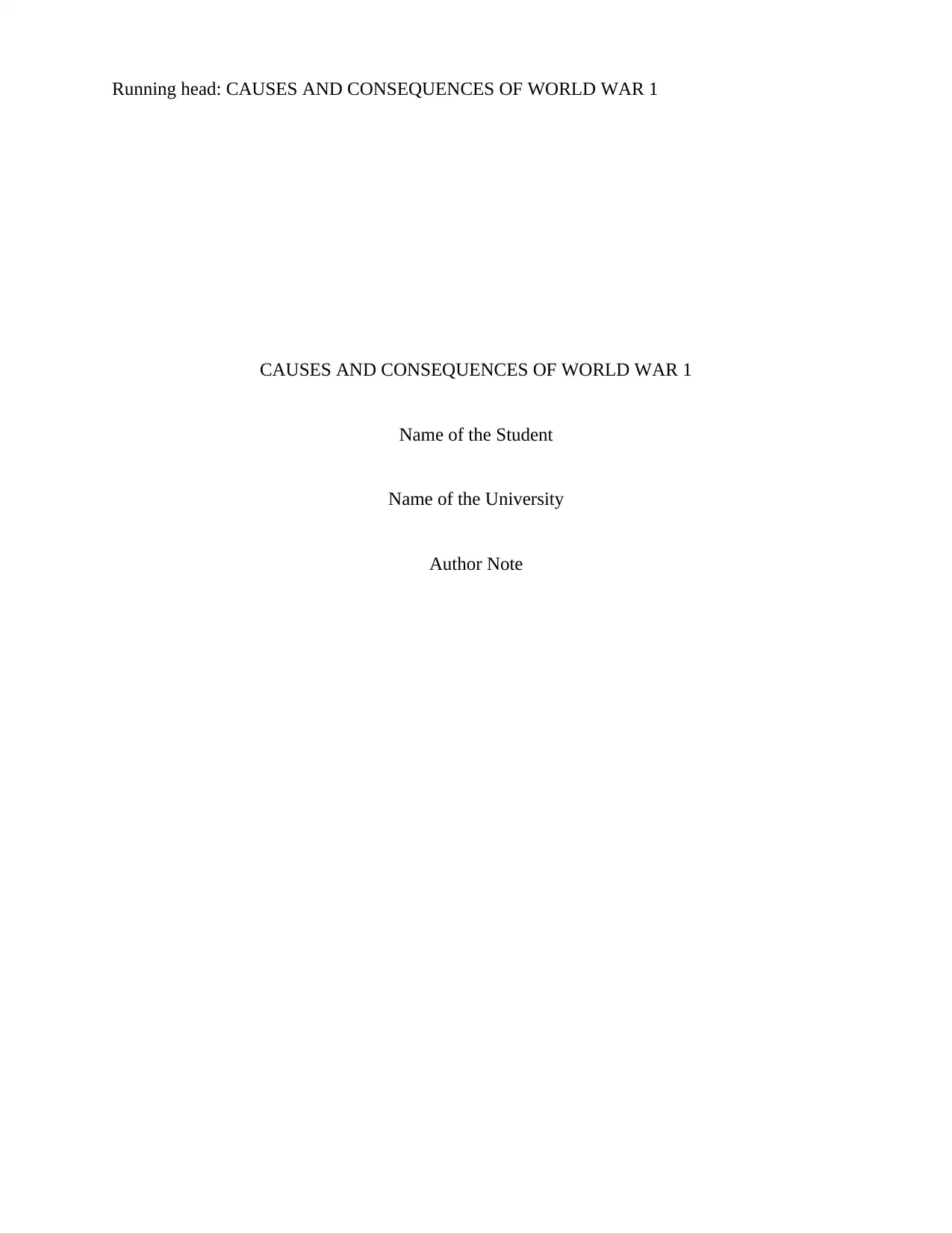
Running head: CAUSES AND CONSEQUENCES OF WORLD WAR 1
CAUSES AND CONSEQUENCES OF WORLD WAR 1
Name of the Student
Name of the University
Author Note
CAUSES AND CONSEQUENCES OF WORLD WAR 1
Name of the Student
Name of the University
Author Note
Secure Best Marks with AI Grader
Need help grading? Try our AI Grader for instant feedback on your assignments.
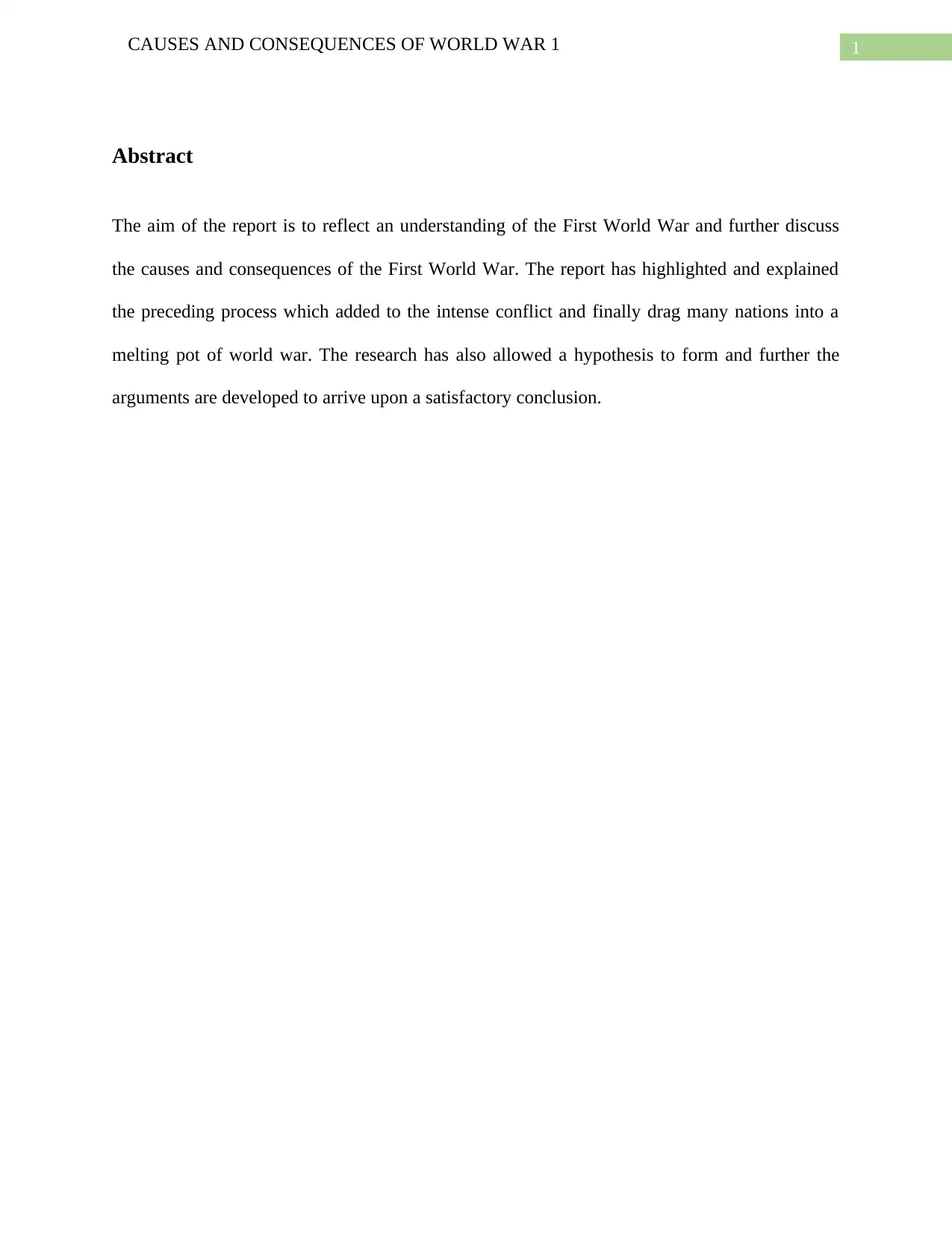
1CAUSES AND CONSEQUENCES OF WORLD WAR 1
Abstract
The aim of the report is to reflect an understanding of the First World War and further discuss
the causes and consequences of the First World War. The report has highlighted and explained
the preceding process which added to the intense conflict and finally drag many nations into a
melting pot of world war. The research has also allowed a hypothesis to form and further the
arguments are developed to arrive upon a satisfactory conclusion.
Abstract
The aim of the report is to reflect an understanding of the First World War and further discuss
the causes and consequences of the First World War. The report has highlighted and explained
the preceding process which added to the intense conflict and finally drag many nations into a
melting pot of world war. The research has also allowed a hypothesis to form and further the
arguments are developed to arrive upon a satisfactory conclusion.
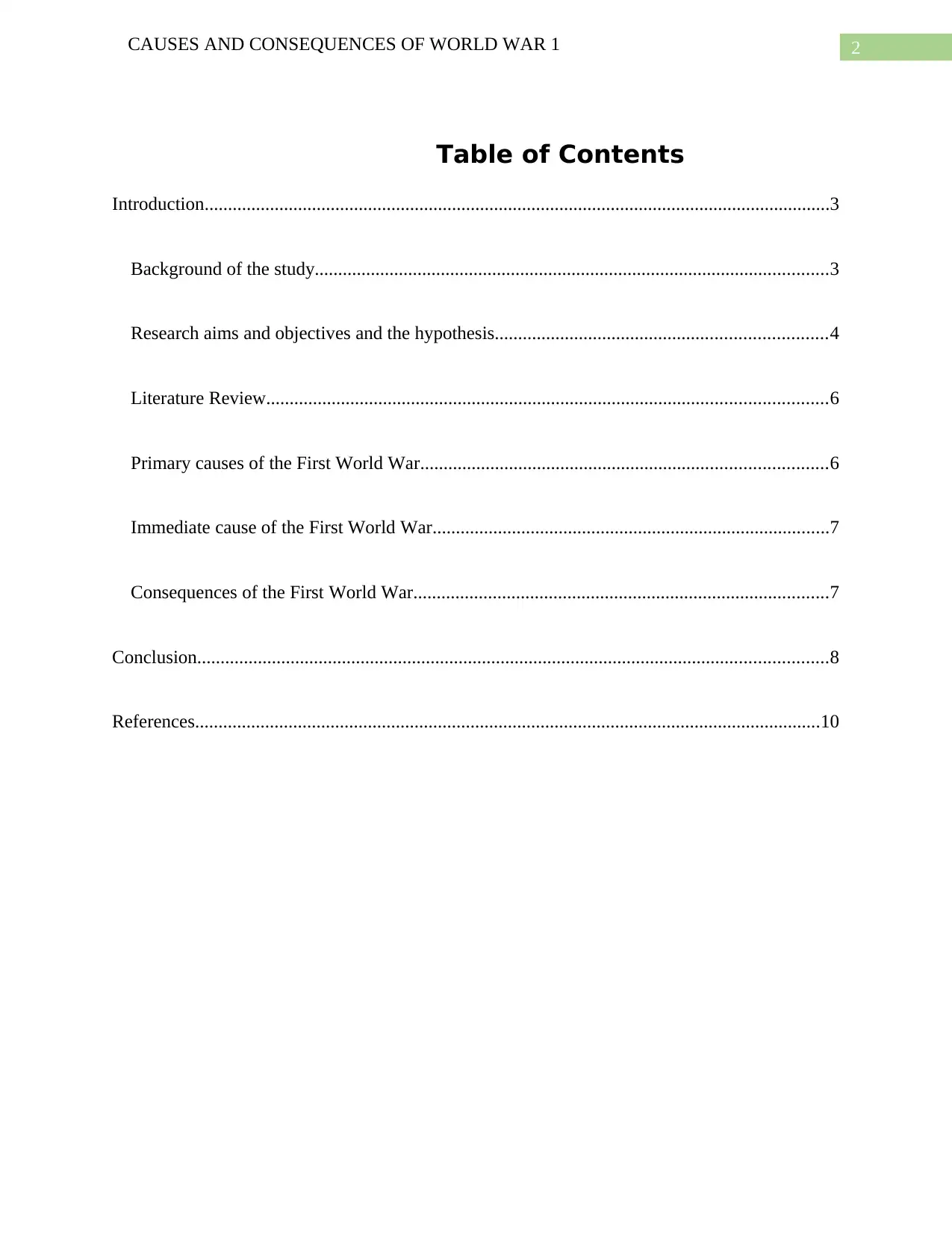
2CAUSES AND CONSEQUENCES OF WORLD WAR 1
Table of Contents
Introduction......................................................................................................................................3
Background of the study..............................................................................................................3
Research aims and objectives and the hypothesis.......................................................................4
Literature Review........................................................................................................................6
Primary causes of the First World War.......................................................................................6
Immediate cause of the First World War.....................................................................................7
Consequences of the First World War.........................................................................................7
Conclusion.......................................................................................................................................8
References......................................................................................................................................10
Table of Contents
Introduction......................................................................................................................................3
Background of the study..............................................................................................................3
Research aims and objectives and the hypothesis.......................................................................4
Literature Review........................................................................................................................6
Primary causes of the First World War.......................................................................................6
Immediate cause of the First World War.....................................................................................7
Consequences of the First World War.........................................................................................7
Conclusion.......................................................................................................................................8
References......................................................................................................................................10
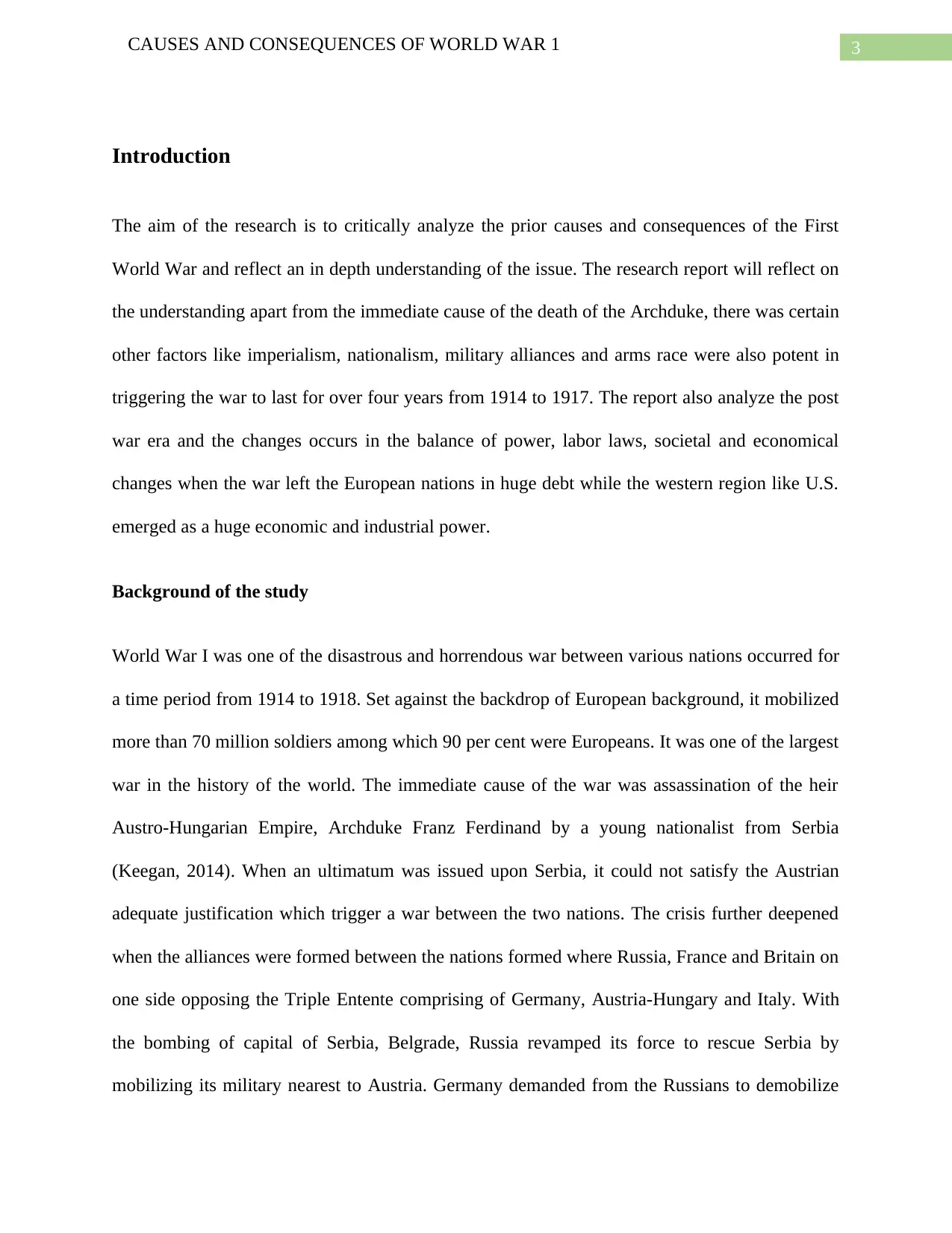
3CAUSES AND CONSEQUENCES OF WORLD WAR 1
Introduction
The aim of the research is to critically analyze the prior causes and consequences of the First
World War and reflect an in depth understanding of the issue. The research report will reflect on
the understanding apart from the immediate cause of the death of the Archduke, there was certain
other factors like imperialism, nationalism, military alliances and arms race were also potent in
triggering the war to last for over four years from 1914 to 1917. The report also analyze the post
war era and the changes occurs in the balance of power, labor laws, societal and economical
changes when the war left the European nations in huge debt while the western region like U.S.
emerged as a huge economic and industrial power.
Background of the study
World War I was one of the disastrous and horrendous war between various nations occurred for
a time period from 1914 to 1918. Set against the backdrop of European background, it mobilized
more than 70 million soldiers among which 90 per cent were Europeans. It was one of the largest
war in the history of the world. The immediate cause of the war was assassination of the heir
Austro-Hungarian Empire, Archduke Franz Ferdinand by a young nationalist from Serbia
(Keegan, 2014). When an ultimatum was issued upon Serbia, it could not satisfy the Austrian
adequate justification which trigger a war between the two nations. The crisis further deepened
when the alliances were formed between the nations formed where Russia, France and Britain on
one side opposing the Triple Entente comprising of Germany, Austria-Hungary and Italy. With
the bombing of capital of Serbia, Belgrade, Russia revamped its force to rescue Serbia by
mobilizing its military nearest to Austria. Germany demanded from the Russians to demobilize
Introduction
The aim of the research is to critically analyze the prior causes and consequences of the First
World War and reflect an in depth understanding of the issue. The research report will reflect on
the understanding apart from the immediate cause of the death of the Archduke, there was certain
other factors like imperialism, nationalism, military alliances and arms race were also potent in
triggering the war to last for over four years from 1914 to 1917. The report also analyze the post
war era and the changes occurs in the balance of power, labor laws, societal and economical
changes when the war left the European nations in huge debt while the western region like U.S.
emerged as a huge economic and industrial power.
Background of the study
World War I was one of the disastrous and horrendous war between various nations occurred for
a time period from 1914 to 1918. Set against the backdrop of European background, it mobilized
more than 70 million soldiers among which 90 per cent were Europeans. It was one of the largest
war in the history of the world. The immediate cause of the war was assassination of the heir
Austro-Hungarian Empire, Archduke Franz Ferdinand by a young nationalist from Serbia
(Keegan, 2014). When an ultimatum was issued upon Serbia, it could not satisfy the Austrian
adequate justification which trigger a war between the two nations. The crisis further deepened
when the alliances were formed between the nations formed where Russia, France and Britain on
one side opposing the Triple Entente comprising of Germany, Austria-Hungary and Italy. With
the bombing of capital of Serbia, Belgrade, Russia revamped its force to rescue Serbia by
mobilizing its military nearest to Austria. Germany demanded from the Russians to demobilize
Secure Best Marks with AI Grader
Need help grading? Try our AI Grader for instant feedback on your assignments.
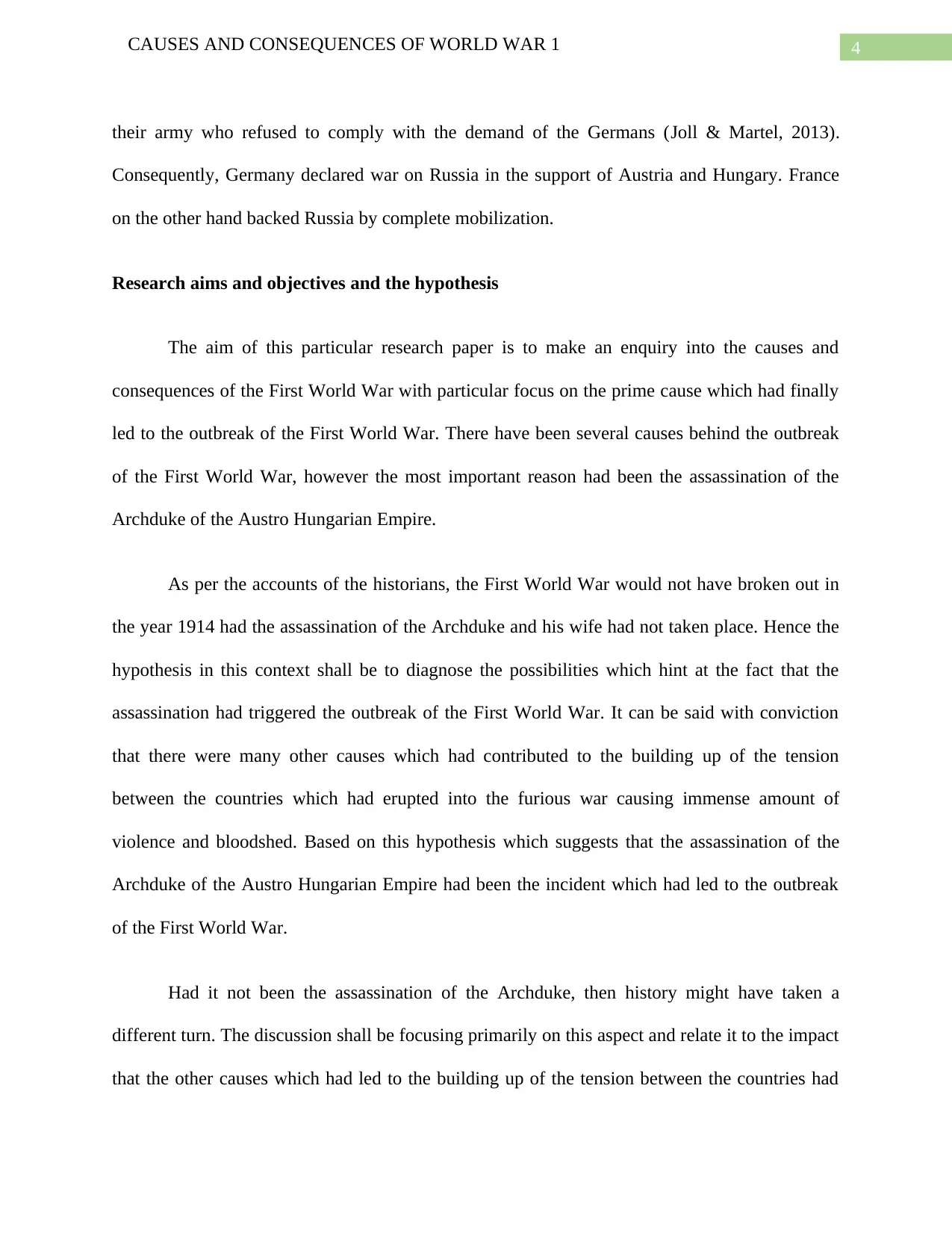
4CAUSES AND CONSEQUENCES OF WORLD WAR 1
their army who refused to comply with the demand of the Germans (Joll & Martel, 2013).
Consequently, Germany declared war on Russia in the support of Austria and Hungary. France
on the other hand backed Russia by complete mobilization.
Research aims and objectives and the hypothesis
The aim of this particular research paper is to make an enquiry into the causes and
consequences of the First World War with particular focus on the prime cause which had finally
led to the outbreak of the First World War. There have been several causes behind the outbreak
of the First World War, however the most important reason had been the assassination of the
Archduke of the Austro Hungarian Empire.
As per the accounts of the historians, the First World War would not have broken out in
the year 1914 had the assassination of the Archduke and his wife had not taken place. Hence the
hypothesis in this context shall be to diagnose the possibilities which hint at the fact that the
assassination had triggered the outbreak of the First World War. It can be said with conviction
that there were many other causes which had contributed to the building up of the tension
between the countries which had erupted into the furious war causing immense amount of
violence and bloodshed. Based on this hypothesis which suggests that the assassination of the
Archduke of the Austro Hungarian Empire had been the incident which had led to the outbreak
of the First World War.
Had it not been the assassination of the Archduke, then history might have taken a
different turn. The discussion shall be focusing primarily on this aspect and relate it to the impact
that the other causes which had led to the building up of the tension between the countries had
their army who refused to comply with the demand of the Germans (Joll & Martel, 2013).
Consequently, Germany declared war on Russia in the support of Austria and Hungary. France
on the other hand backed Russia by complete mobilization.
Research aims and objectives and the hypothesis
The aim of this particular research paper is to make an enquiry into the causes and
consequences of the First World War with particular focus on the prime cause which had finally
led to the outbreak of the First World War. There have been several causes behind the outbreak
of the First World War, however the most important reason had been the assassination of the
Archduke of the Austro Hungarian Empire.
As per the accounts of the historians, the First World War would not have broken out in
the year 1914 had the assassination of the Archduke and his wife had not taken place. Hence the
hypothesis in this context shall be to diagnose the possibilities which hint at the fact that the
assassination had triggered the outbreak of the First World War. It can be said with conviction
that there were many other causes which had contributed to the building up of the tension
between the countries which had erupted into the furious war causing immense amount of
violence and bloodshed. Based on this hypothesis which suggests that the assassination of the
Archduke of the Austro Hungarian Empire had been the incident which had led to the outbreak
of the First World War.
Had it not been the assassination of the Archduke, then history might have taken a
different turn. The discussion shall be focusing primarily on this aspect and relate it to the impact
that the other causes which had led to the building up of the tension between the countries had
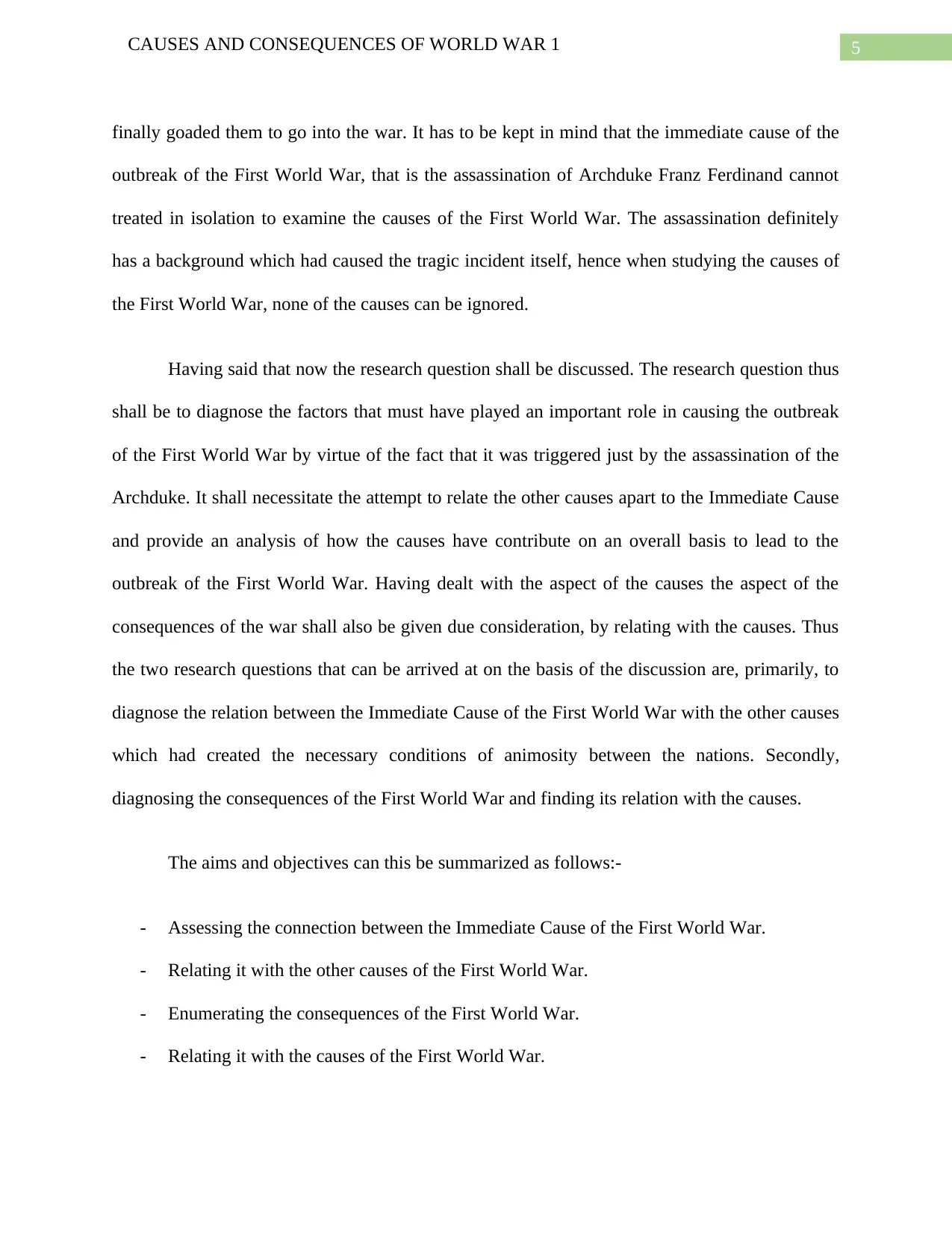
5CAUSES AND CONSEQUENCES OF WORLD WAR 1
finally goaded them to go into the war. It has to be kept in mind that the immediate cause of the
outbreak of the First World War, that is the assassination of Archduke Franz Ferdinand cannot
treated in isolation to examine the causes of the First World War. The assassination definitely
has a background which had caused the tragic incident itself, hence when studying the causes of
the First World War, none of the causes can be ignored.
Having said that now the research question shall be discussed. The research question thus
shall be to diagnose the factors that must have played an important role in causing the outbreak
of the First World War by virtue of the fact that it was triggered just by the assassination of the
Archduke. It shall necessitate the attempt to relate the other causes apart to the Immediate Cause
and provide an analysis of how the causes have contribute on an overall basis to lead to the
outbreak of the First World War. Having dealt with the aspect of the causes the aspect of the
consequences of the war shall also be given due consideration, by relating with the causes. Thus
the two research questions that can be arrived at on the basis of the discussion are, primarily, to
diagnose the relation between the Immediate Cause of the First World War with the other causes
which had created the necessary conditions of animosity between the nations. Secondly,
diagnosing the consequences of the First World War and finding its relation with the causes.
The aims and objectives can this be summarized as follows:-
- Assessing the connection between the Immediate Cause of the First World War.
- Relating it with the other causes of the First World War.
- Enumerating the consequences of the First World War.
- Relating it with the causes of the First World War.
finally goaded them to go into the war. It has to be kept in mind that the immediate cause of the
outbreak of the First World War, that is the assassination of Archduke Franz Ferdinand cannot
treated in isolation to examine the causes of the First World War. The assassination definitely
has a background which had caused the tragic incident itself, hence when studying the causes of
the First World War, none of the causes can be ignored.
Having said that now the research question shall be discussed. The research question thus
shall be to diagnose the factors that must have played an important role in causing the outbreak
of the First World War by virtue of the fact that it was triggered just by the assassination of the
Archduke. It shall necessitate the attempt to relate the other causes apart to the Immediate Cause
and provide an analysis of how the causes have contribute on an overall basis to lead to the
outbreak of the First World War. Having dealt with the aspect of the causes the aspect of the
consequences of the war shall also be given due consideration, by relating with the causes. Thus
the two research questions that can be arrived at on the basis of the discussion are, primarily, to
diagnose the relation between the Immediate Cause of the First World War with the other causes
which had created the necessary conditions of animosity between the nations. Secondly,
diagnosing the consequences of the First World War and finding its relation with the causes.
The aims and objectives can this be summarized as follows:-
- Assessing the connection between the Immediate Cause of the First World War.
- Relating it with the other causes of the First World War.
- Enumerating the consequences of the First World War.
- Relating it with the causes of the First World War.
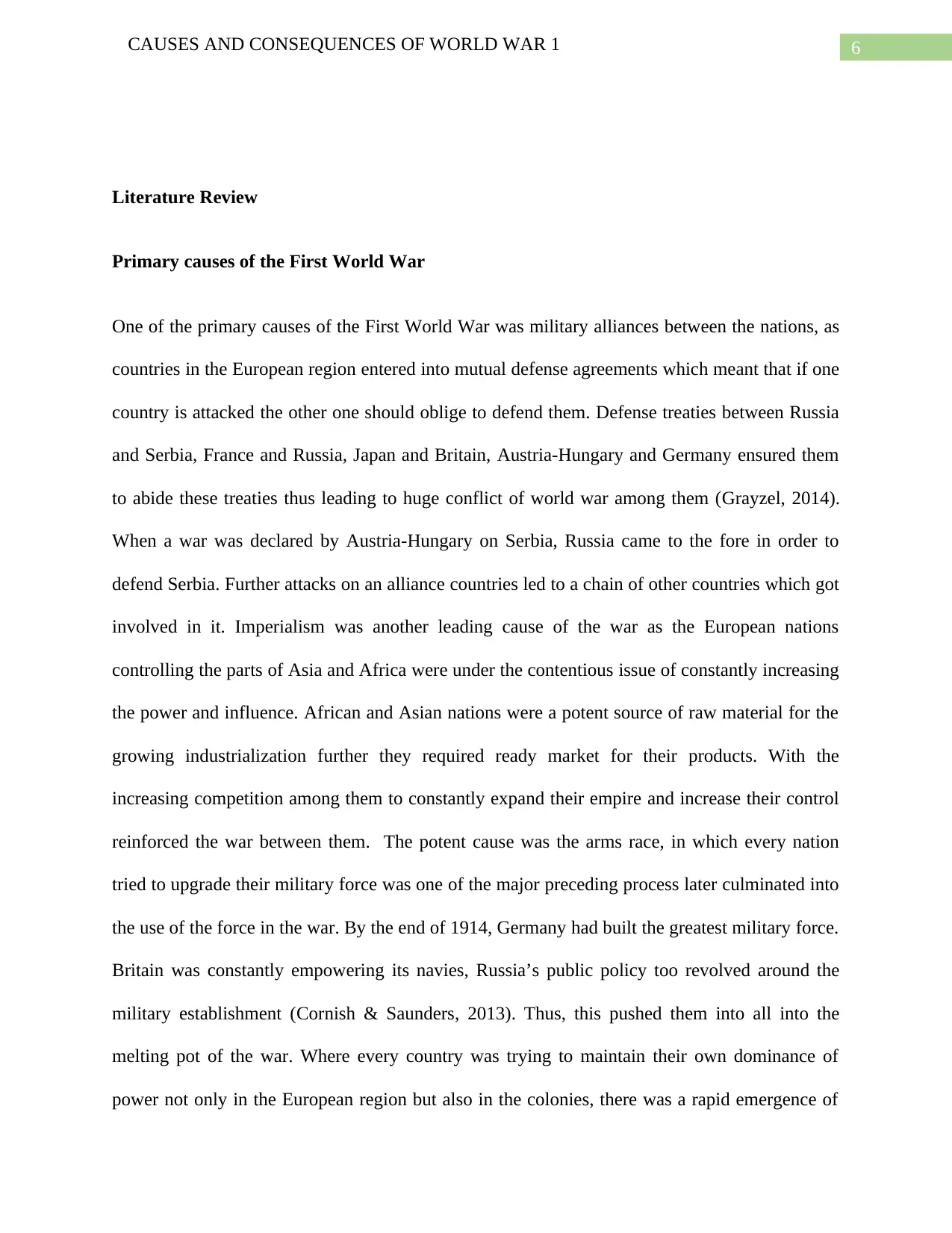
6CAUSES AND CONSEQUENCES OF WORLD WAR 1
Literature Review
Primary causes of the First World War
One of the primary causes of the First World War was military alliances between the nations, as
countries in the European region entered into mutual defense agreements which meant that if one
country is attacked the other one should oblige to defend them. Defense treaties between Russia
and Serbia, France and Russia, Japan and Britain, Austria-Hungary and Germany ensured them
to abide these treaties thus leading to huge conflict of world war among them (Grayzel, 2014).
When a war was declared by Austria-Hungary on Serbia, Russia came to the fore in order to
defend Serbia. Further attacks on an alliance countries led to a chain of other countries which got
involved in it. Imperialism was another leading cause of the war as the European nations
controlling the parts of Asia and Africa were under the contentious issue of constantly increasing
the power and influence. African and Asian nations were a potent source of raw material for the
growing industrialization further they required ready market for their products. With the
increasing competition among them to constantly expand their empire and increase their control
reinforced the war between them. The potent cause was the arms race, in which every nation
tried to upgrade their military force was one of the major preceding process later culminated into
the use of the force in the war. By the end of 1914, Germany had built the greatest military force.
Britain was constantly empowering its navies, Russia’s public policy too revolved around the
military establishment (Cornish & Saunders, 2013). Thus, this pushed them into all into the
melting pot of the war. Where every country was trying to maintain their own dominance of
power not only in the European region but also in the colonies, there was a rapid emergence of
Literature Review
Primary causes of the First World War
One of the primary causes of the First World War was military alliances between the nations, as
countries in the European region entered into mutual defense agreements which meant that if one
country is attacked the other one should oblige to defend them. Defense treaties between Russia
and Serbia, France and Russia, Japan and Britain, Austria-Hungary and Germany ensured them
to abide these treaties thus leading to huge conflict of world war among them (Grayzel, 2014).
When a war was declared by Austria-Hungary on Serbia, Russia came to the fore in order to
defend Serbia. Further attacks on an alliance countries led to a chain of other countries which got
involved in it. Imperialism was another leading cause of the war as the European nations
controlling the parts of Asia and Africa were under the contentious issue of constantly increasing
the power and influence. African and Asian nations were a potent source of raw material for the
growing industrialization further they required ready market for their products. With the
increasing competition among them to constantly expand their empire and increase their control
reinforced the war between them. The potent cause was the arms race, in which every nation
tried to upgrade their military force was one of the major preceding process later culminated into
the use of the force in the war. By the end of 1914, Germany had built the greatest military force.
Britain was constantly empowering its navies, Russia’s public policy too revolved around the
military establishment (Cornish & Saunders, 2013). Thus, this pushed them into all into the
melting pot of the war. Where every country was trying to maintain their own dominance of
power not only in the European region but also in the colonies, there was a rapid emergence of
Paraphrase This Document
Need a fresh take? Get an instant paraphrase of this document with our AI Paraphraser
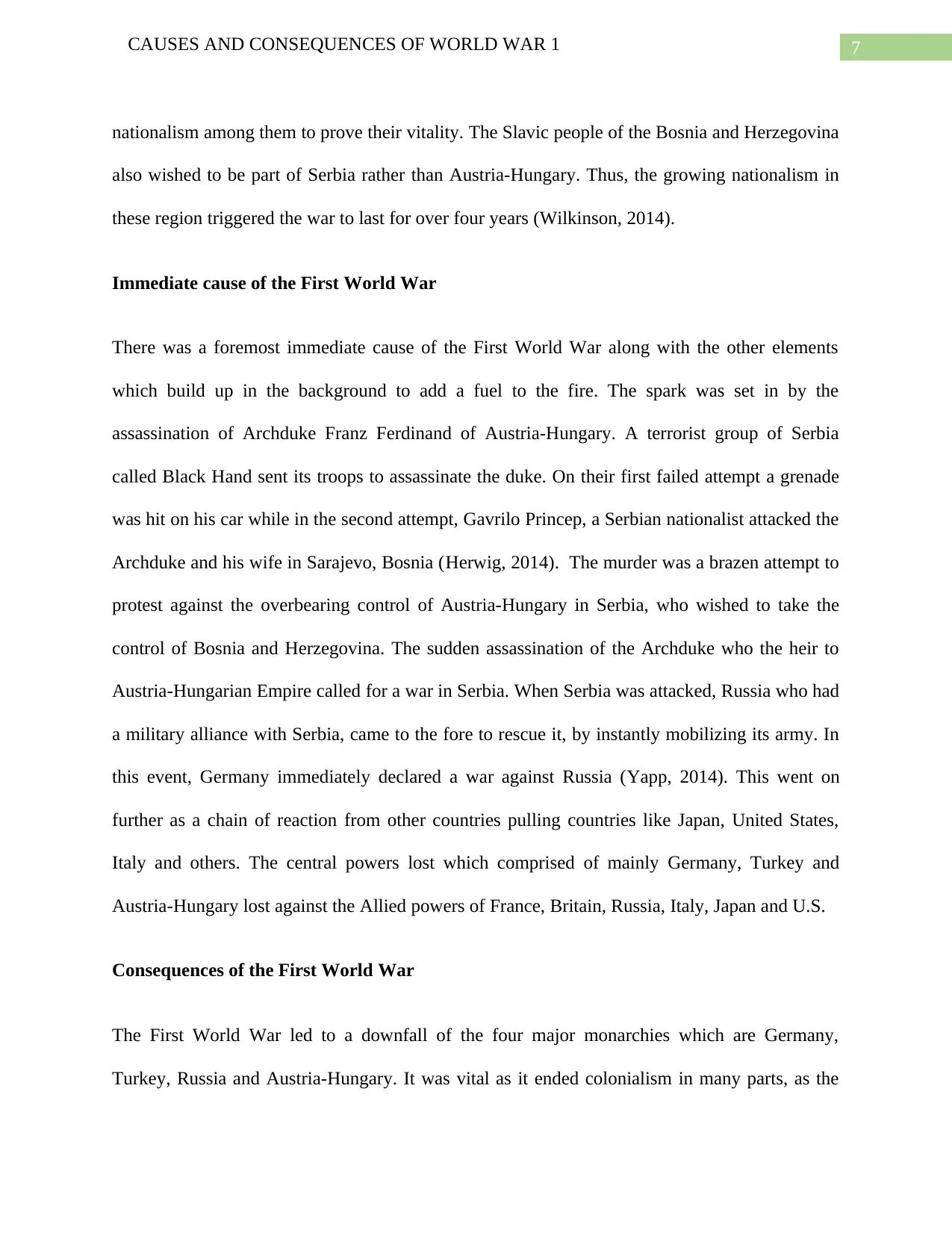
7CAUSES AND CONSEQUENCES OF WORLD WAR 1
nationalism among them to prove their vitality. The Slavic people of the Bosnia and Herzegovina
also wished to be part of Serbia rather than Austria-Hungary. Thus, the growing nationalism in
these region triggered the war to last for over four years (Wilkinson, 2014).
Immediate cause of the First World War
There was a foremost immediate cause of the First World War along with the other elements
which build up in the background to add a fuel to the fire. The spark was set in by the
assassination of Archduke Franz Ferdinand of Austria-Hungary. A terrorist group of Serbia
called Black Hand sent its troops to assassinate the duke. On their first failed attempt a grenade
was hit on his car while in the second attempt, Gavrilo Princep, a Serbian nationalist attacked the
Archduke and his wife in Sarajevo, Bosnia (Herwig, 2014). The murder was a brazen attempt to
protest against the overbearing control of Austria-Hungary in Serbia, who wished to take the
control of Bosnia and Herzegovina. The sudden assassination of the Archduke who the heir to
Austria-Hungarian Empire called for a war in Serbia. When Serbia was attacked, Russia who had
a military alliance with Serbia, came to the fore to rescue it, by instantly mobilizing its army. In
this event, Germany immediately declared a war against Russia (Yapp, 2014). This went on
further as a chain of reaction from other countries pulling countries like Japan, United States,
Italy and others. The central powers lost which comprised of mainly Germany, Turkey and
Austria-Hungary lost against the Allied powers of France, Britain, Russia, Italy, Japan and U.S.
Consequences of the First World War
The First World War led to a downfall of the four major monarchies which are Germany,
Turkey, Russia and Austria-Hungary. It was vital as it ended colonialism in many parts, as the
nationalism among them to prove their vitality. The Slavic people of the Bosnia and Herzegovina
also wished to be part of Serbia rather than Austria-Hungary. Thus, the growing nationalism in
these region triggered the war to last for over four years (Wilkinson, 2014).
Immediate cause of the First World War
There was a foremost immediate cause of the First World War along with the other elements
which build up in the background to add a fuel to the fire. The spark was set in by the
assassination of Archduke Franz Ferdinand of Austria-Hungary. A terrorist group of Serbia
called Black Hand sent its troops to assassinate the duke. On their first failed attempt a grenade
was hit on his car while in the second attempt, Gavrilo Princep, a Serbian nationalist attacked the
Archduke and his wife in Sarajevo, Bosnia (Herwig, 2014). The murder was a brazen attempt to
protest against the overbearing control of Austria-Hungary in Serbia, who wished to take the
control of Bosnia and Herzegovina. The sudden assassination of the Archduke who the heir to
Austria-Hungarian Empire called for a war in Serbia. When Serbia was attacked, Russia who had
a military alliance with Serbia, came to the fore to rescue it, by instantly mobilizing its army. In
this event, Germany immediately declared a war against Russia (Yapp, 2014). This went on
further as a chain of reaction from other countries pulling countries like Japan, United States,
Italy and others. The central powers lost which comprised of mainly Germany, Turkey and
Austria-Hungary lost against the Allied powers of France, Britain, Russia, Italy, Japan and U.S.
Consequences of the First World War
The First World War led to a downfall of the four major monarchies which are Germany,
Turkey, Russia and Austria-Hungary. It was vital as it ended colonialism in many parts, as the
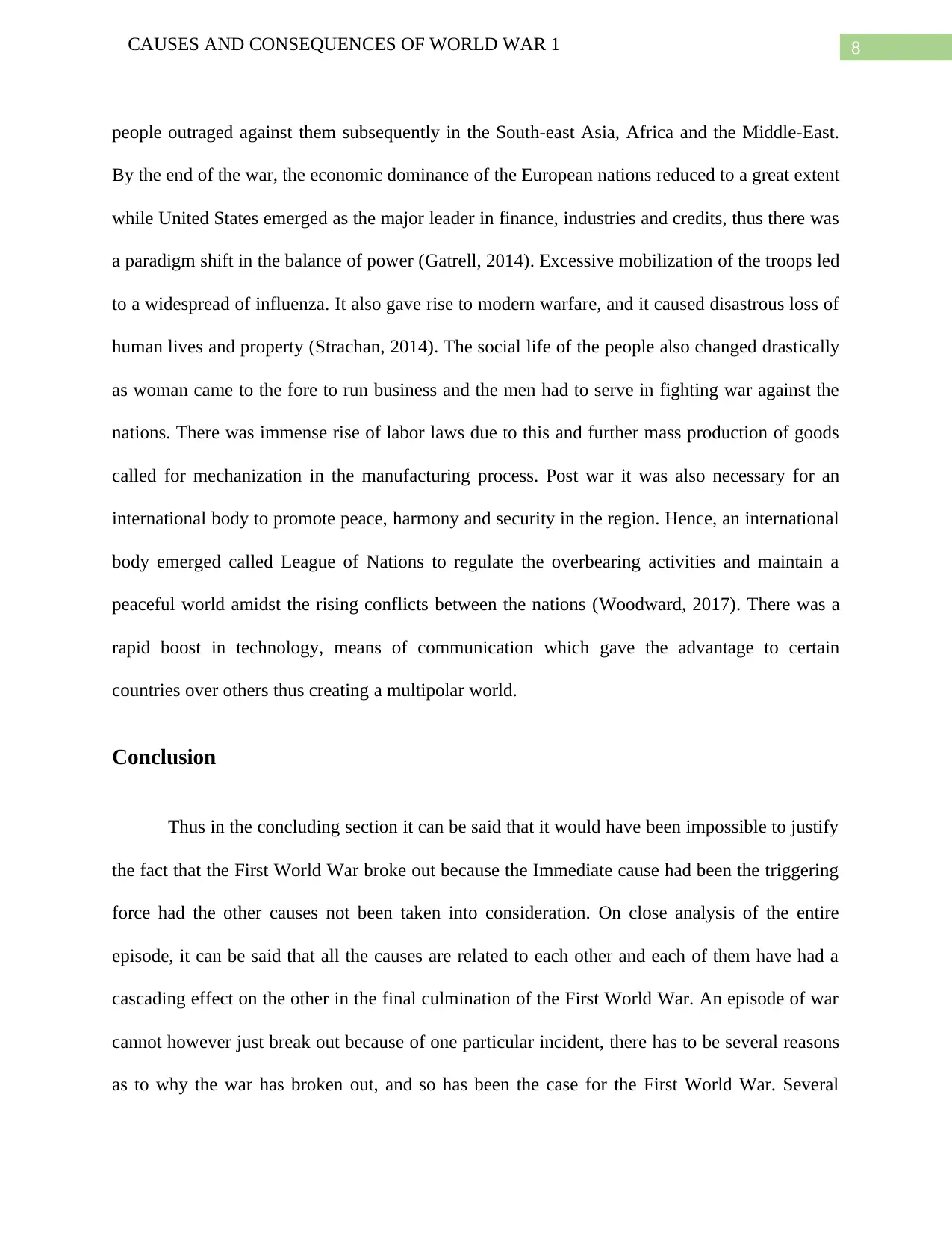
8CAUSES AND CONSEQUENCES OF WORLD WAR 1
people outraged against them subsequently in the South-east Asia, Africa and the Middle-East.
By the end of the war, the economic dominance of the European nations reduced to a great extent
while United States emerged as the major leader in finance, industries and credits, thus there was
a paradigm shift in the balance of power (Gatrell, 2014). Excessive mobilization of the troops led
to a widespread of influenza. It also gave rise to modern warfare, and it caused disastrous loss of
human lives and property (Strachan, 2014). The social life of the people also changed drastically
as woman came to the fore to run business and the men had to serve in fighting war against the
nations. There was immense rise of labor laws due to this and further mass production of goods
called for mechanization in the manufacturing process. Post war it was also necessary for an
international body to promote peace, harmony and security in the region. Hence, an international
body emerged called League of Nations to regulate the overbearing activities and maintain a
peaceful world amidst the rising conflicts between the nations (Woodward, 2017). There was a
rapid boost in technology, means of communication which gave the advantage to certain
countries over others thus creating a multipolar world.
Conclusion
Thus in the concluding section it can be said that it would have been impossible to justify
the fact that the First World War broke out because the Immediate cause had been the triggering
force had the other causes not been taken into consideration. On close analysis of the entire
episode, it can be said that all the causes are related to each other and each of them have had a
cascading effect on the other in the final culmination of the First World War. An episode of war
cannot however just break out because of one particular incident, there has to be several reasons
as to why the war has broken out, and so has been the case for the First World War. Several
people outraged against them subsequently in the South-east Asia, Africa and the Middle-East.
By the end of the war, the economic dominance of the European nations reduced to a great extent
while United States emerged as the major leader in finance, industries and credits, thus there was
a paradigm shift in the balance of power (Gatrell, 2014). Excessive mobilization of the troops led
to a widespread of influenza. It also gave rise to modern warfare, and it caused disastrous loss of
human lives and property (Strachan, 2014). The social life of the people also changed drastically
as woman came to the fore to run business and the men had to serve in fighting war against the
nations. There was immense rise of labor laws due to this and further mass production of goods
called for mechanization in the manufacturing process. Post war it was also necessary for an
international body to promote peace, harmony and security in the region. Hence, an international
body emerged called League of Nations to regulate the overbearing activities and maintain a
peaceful world amidst the rising conflicts between the nations (Woodward, 2017). There was a
rapid boost in technology, means of communication which gave the advantage to certain
countries over others thus creating a multipolar world.
Conclusion
Thus in the concluding section it can be said that it would have been impossible to justify
the fact that the First World War broke out because the Immediate cause had been the triggering
force had the other causes not been taken into consideration. On close analysis of the entire
episode, it can be said that all the causes are related to each other and each of them have had a
cascading effect on the other in the final culmination of the First World War. An episode of war
cannot however just break out because of one particular incident, there has to be several reasons
as to why the war has broken out, and so has been the case for the First World War. Several
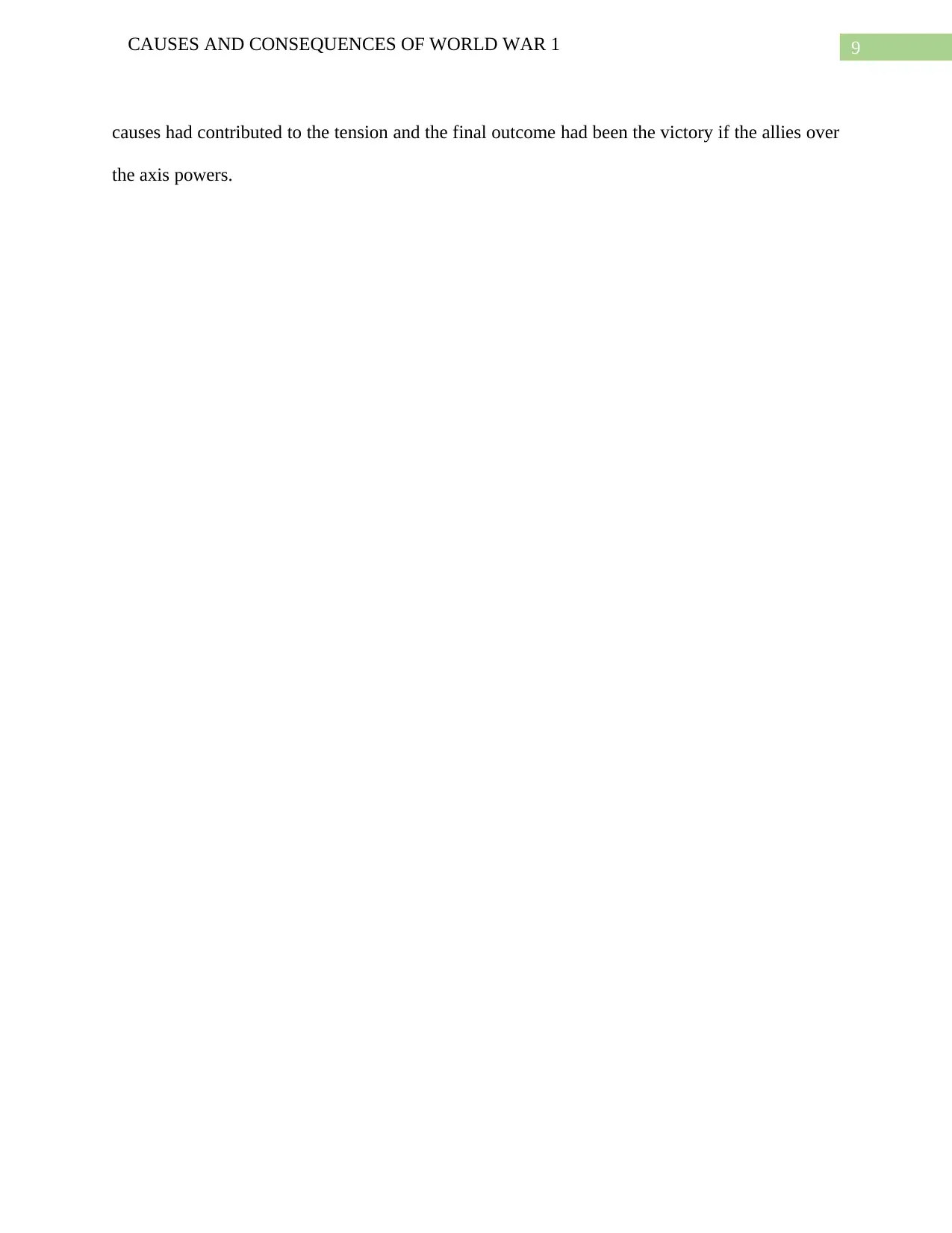
9CAUSES AND CONSEQUENCES OF WORLD WAR 1
causes had contributed to the tension and the final outcome had been the victory if the allies over
the axis powers.
causes had contributed to the tension and the final outcome had been the victory if the allies over
the axis powers.
Secure Best Marks with AI Grader
Need help grading? Try our AI Grader for instant feedback on your assignments.
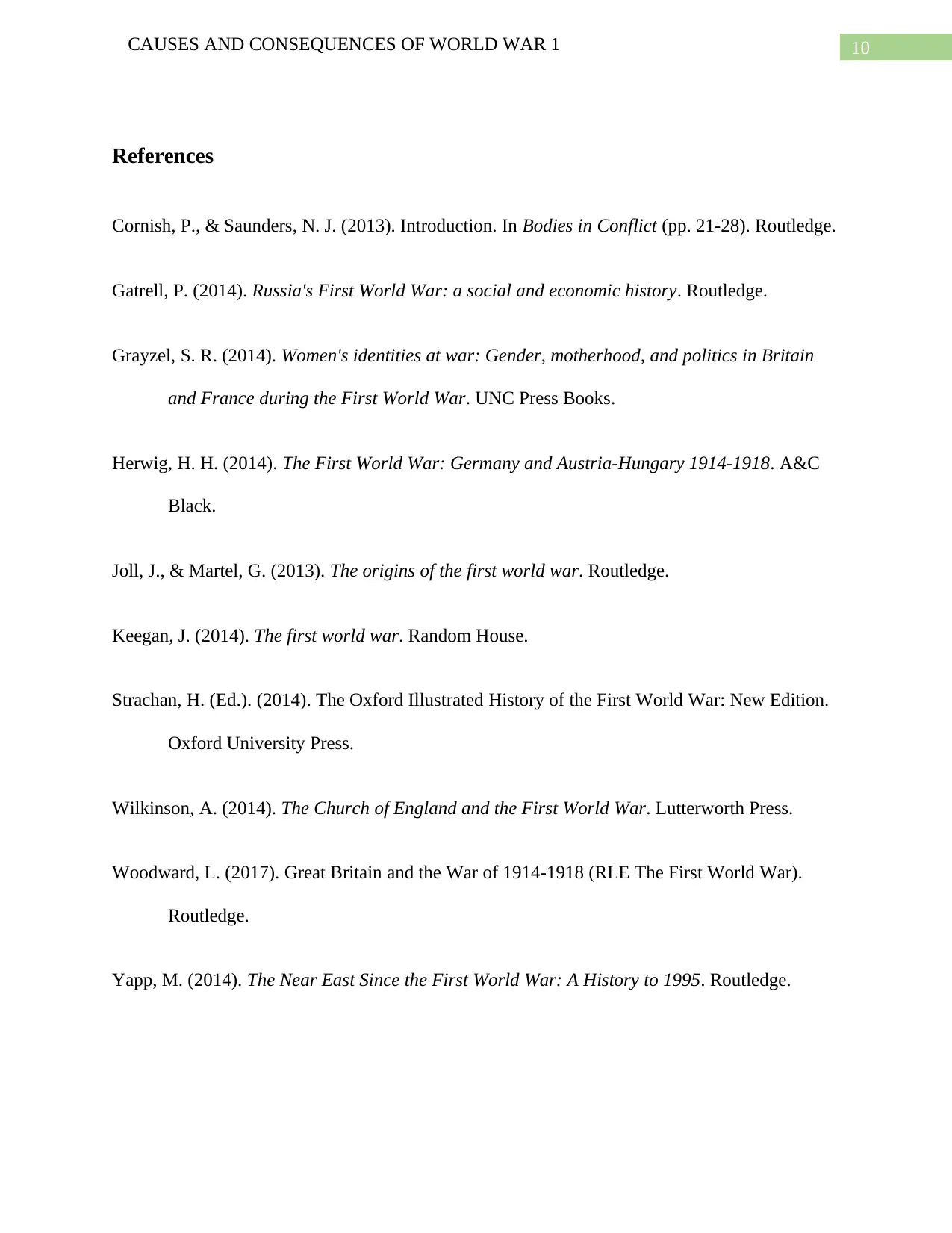
10CAUSES AND CONSEQUENCES OF WORLD WAR 1
References
Cornish, P., & Saunders, N. J. (2013). Introduction. In Bodies in Conflict (pp. 21-28). Routledge.
Gatrell, P. (2014). Russia's First World War: a social and economic history. Routledge.
Grayzel, S. R. (2014). Women's identities at war: Gender, motherhood, and politics in Britain
and France during the First World War. UNC Press Books.
Herwig, H. H. (2014). The First World War: Germany and Austria-Hungary 1914-1918. A&C
Black.
Joll, J., & Martel, G. (2013). The origins of the first world war. Routledge.
Keegan, J. (2014). The first world war. Random House.
Strachan, H. (Ed.). (2014). The Oxford Illustrated History of the First World War: New Edition.
Oxford University Press.
Wilkinson, A. (2014). The Church of England and the First World War. Lutterworth Press.
Woodward, L. (2017). Great Britain and the War of 1914-1918 (RLE The First World War).
Routledge.
Yapp, M. (2014). The Near East Since the First World War: A History to 1995. Routledge.
References
Cornish, P., & Saunders, N. J. (2013). Introduction. In Bodies in Conflict (pp. 21-28). Routledge.
Gatrell, P. (2014). Russia's First World War: a social and economic history. Routledge.
Grayzel, S. R. (2014). Women's identities at war: Gender, motherhood, and politics in Britain
and France during the First World War. UNC Press Books.
Herwig, H. H. (2014). The First World War: Germany and Austria-Hungary 1914-1918. A&C
Black.
Joll, J., & Martel, G. (2013). The origins of the first world war. Routledge.
Keegan, J. (2014). The first world war. Random House.
Strachan, H. (Ed.). (2014). The Oxford Illustrated History of the First World War: New Edition.
Oxford University Press.
Wilkinson, A. (2014). The Church of England and the First World War. Lutterworth Press.
Woodward, L. (2017). Great Britain and the War of 1914-1918 (RLE The First World War).
Routledge.
Yapp, M. (2014). The Near East Since the First World War: A History to 1995. Routledge.
1 out of 11
Related Documents
Your All-in-One AI-Powered Toolkit for Academic Success.
+13062052269
info@desklib.com
Available 24*7 on WhatsApp / Email
![[object Object]](/_next/static/media/star-bottom.7253800d.svg)
Unlock your academic potential
© 2024 | Zucol Services PVT LTD | All rights reserved.





